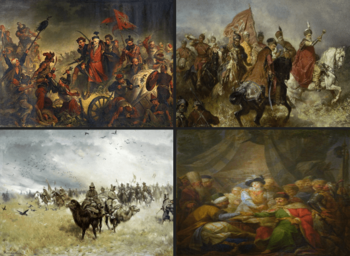Polish–Ottoman War (1620–1621) facts for kids
Quick facts for kids Polish–Ottoman War (1620–1621) |
|||||||||
|---|---|---|---|---|---|---|---|---|---|
| Part of the Polish–Ottoman Wars and the Thirty Years' War | |||||||||
 From top left:
|
|||||||||
|
|||||||||
| Belligerents | |||||||||
| Commanders and leaders | |||||||||
| Stanisław Żółkiewski † Jan Karol Chodkiewicz # Crown Prince Vasa |
Osman II Güzelce Ali Pasha Ohrili Hüseyin Pasha Abaza Mehmed Pasha |
||||||||
| Strength | |||||||||
|
25,000 Polish-Lithuanian troops 20,000 Cossacks |
120,000–160,000 Ottoman and Tatar, 13,000 Moldavian and Wallachian troops |
||||||||
| Casualties and losses | |||||||||
| 14,000 | 40,000 | ||||||||
The Polish–Ottoman War (1620–1621) was a fight between two big powers: the Polish–Lithuanian Commonwealth and the Ottoman Empire. They were fighting over who would control a region called Moldavia. The war ended with a peace treaty. The Commonwealth agreed to stop trying to control Moldavia. This war also led to the fall of the Ottoman ruler, Sultan Osman II.
Contents
What Caused the War?
For a long time, Moldavia had been connected to the Kingdom of Poland. Later, it was linked to the Polish–Lithuanian Commonwealth. But as the Ottoman Empire grew stronger in the 1500s, they also became very interested in Moldavia.
Moldavia: A Land in the Middle
By the late 1500s and early 1600s, powerful nobles from the Polish–Lithuanian Commonwealth, called magnates, started getting involved in Moldavia's politics. The Ottoman Empire saw Moldavia as their own special area of influence. This meant they believed they should be the ones in charge there. The Ottomans were also annoyed by constant attacks from Cossacks. These Cossacks were warriors who lived near the border and were loosely connected to the Commonwealth. They often raided Ottoman lands.
The Big European War: Thirty Years' War
Another reason for the war was a huge conflict happening across Europe called the Thirty Years' War. Gabriel Bethlen, a prince from a region called Transylvania, saw a chance to unite some Hungarian lands. He even attacked Vienna in November 1619. He asked Sultan Osman II for help, but it didn't work out.
The Polish king, Zygmunt III Waza, didn't get too involved in the Thirty Years' War. However, he sent a group of skilled mercenary soldiers called the Lisowczycy to help his allies, the Habsburg family. These soldiers defeated a Hungarian lord named George I Rákóczi in 1619. This cut off supplies for Transylvanian forces. Around this time, Gaspar Graziani, the ruler of Moldavia, decided to switch sides and join Poland.
Because of all this, the Sultan agreed to help Bethlen. He gathered a very large Ottoman army. His plan was to invade the Commonwealth and punish them.
The War Begins
In 1620, the Ottoman forces fought the Commonwealth army at the Battle of Ţuţora (also known as Cecora). The Ottomans won a big victory. The fighting stopped for the winter. But in 1621, both sides started fighting again.
The Battle of Khotyn (1621)
After their win at Cecora, the Turks hoped to conquer Ukraine, which was then part of Poland. They even dreamed of taking over the whole Commonwealth and reaching the Baltic Sea. But this time, they were stopped. A Commonwealth army, helped by many Cossack warriors, faced them at the Battle of Khotyn.
About 45,000 Polish and Cossack soldiers stood strong against an Ottoman army that was at least twice their size. They fought for a whole month in September, causing heavy losses to the Ottoman army. In October, when the Polish cavalry charged forward, the Ottoman soldiers lost their will to fight. The Sultan then asked for peace.
What Happened After the War?
The peace treaty that followed, called the Treaty of Khotyn, gave the Fortress of Khotyn to Moldavia. Moldavia remained a state controlled by the Ottomans. The Commonwealth agreed to stop getting involved in Moldavia's affairs. Both sides felt they had won. The Commonwealth stopped the Ottoman invasion of its main lands. The Ottoman Empire achieved its goal of removing the threat from Moldavian lands.
The border between Poland and the Ottoman Empire stayed mostly peaceful for a while. This peace lasted until the next wars in 1633–34 and 1672–76.
See Also
- Moldavian Magnate Wars

